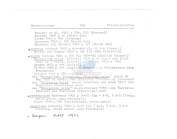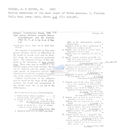Deep-Sea name details
Trichotheristus Wieser, 1956
2470 (urn:lsid:marinespecies.org:taxname:2470)
unaccepted (Aryuthaka, C & Kito, K. 2018)
Genus
marine
Wieser, W. (1956). Free-living marine nematodes III. Axonolaimoidea and Monhysteroidea. <em>Acta Univ Lund N. F. Avd.</em> 2. Bd 52. Nr 13: 1-115. [details] Available for editors 
Taxonomic remark Daptonema chonispiculum sp. n. and D. phuketense sp. n. are described from the Ban Pa Khlok seagrass bed, Phuket Province,...
Taxonomic remark Wieser, W. (1956) described Trichotheristus as a subgenus of Theristus.
Taxonomic remark Daptonema chonispiculum sp. n. and D. phuketense sp. n. are described from the Ban Pa Khlok seagrass bed, Phuket Province, Thailand. Daptonema chonispiculum sp. n. is characterized by spicules with funnel-shaped proximal ends, and D. phuketense sp. n. is unique in having the third caudal gland filled with fibrous contents. Each new species also differs from most related species in body length, de Man’s indices, length of the cephalic setae and somatic/cervical setae, distance of the amphids from the anterior of the body, and length of the spicules. The new species most closely resemble D. hirsutum, D. platonovae, and D. robustum, with similar body lengths, long cervical setae located in the anterior pharyngeal region, small amphids, L-shaped spicules and a gubernaculum with a long dorso-caudal apophysis. Regarding the taxonomic status of Daptonema and Trichotheristus, we agree with the synonymization of Trichotheristus with Daptonema by Tchesunov (1990), based on taxonomic review of Trichotheristus and a comparison of the diagnostic features separating the genera. We propose a new combination, Daptonema galeatum comb. n., and a new name, Daptonema nearticulatum sp. n. for Trichotheristus articulatus Huang & Zhang, 2006. [details]
Taxonomic remark Wieser, W. (1956) described Trichotheristus as a subgenus of Theristus.
Taxonomic remark Wieser, W. (1956) described Trichotheristus as a subgenus of Theristus. [details]
Nemys eds. (2024). Nemys: World Database of Nematodes. Trichotheristus Wieser, 1956. Accessed through: Glover, A.G.; Higgs, N.; Horton, T. (2024) World Register of Deep-Sea species (WoRDSS) at: https://marinespecies.org/deepsea/aphia.php?p=taxdetails&id=2470 on 2024-04-18
Glover, A.G.; Higgs, N.; Horton, T. (2024). World Register of Deep-Sea species (WoRDSS). Trichotheristus Wieser, 1956. Accessed at: https://marinespecies.org/deepsea/aphia.php?p=taxdetails&id=2470 on 2024-04-18
Date
action
by
2004-12-21 15:54:05Z
created
db_admin
original description
Wieser, W. (1956). Free-living marine nematodes III. Axonolaimoidea and Monhysteroidea. <em>Acta Univ Lund N. F. Avd.</em> 2. Bd 52. Nr 13: 1-115. [details] Available for editors 
basis of record Integrated Taxonomic Information System (ITIS). , available online at http://www.itis.gov [details]
additional source Venekey, V.; Fonseca-Genevois, V.; Santos, P. J. P. (2010). Biodiversity of free-living marine nematodes on the coast of Brazil: a review. <em>Zootaxa.</em> 2568: 39–66. [details] Available for editors
additional source Venekey, V.; Gheller, P. F.; Maria, T. F.; Brustolin, M. C.; Kandratavicius, N.; Vieira, D. C.; Brito, S.; Souza, G. S.; Fonseca, G. (2014). The state of the art of Xyalidae (Nematoda, Monhysterida) with reference to the Brazilian records. <em>Marine Biodiversity.</em> 44(3): 367-390., available online at https://doi.org/10.1007/s12526-014-0226-3 [details] Available for editors
additional source Huang, Y.; Zhang, Z. (2006). Two new species of free-living marine nematodes (<i>Trichotheristus articulatus</i> sp. n. and <i>Leptolaimoides punctatus</i> sp. n.) from the Yellow Sea. <em>Russian Journal of Nematology.</em> 14 (1): 43-50. [details] Available for editors
status source Aryuthaka, C.; Kito, K. (2018). Two new species of the genus Daptonema Cobb, 1920 (Nematoda: Xyalidae) found in an intertidal seagrass bed on the coast of the Andaman Sea, Thailand, with reference to the taxonomic status of the genus Trichotheristus Wieser, 1956. <em>Zootaxa.</em> 4394(1): 77., available online at https://doi.org/10.11646/zootaxa.4394.1.4 [details] Available for editors
ecology source Raes, M.; De Troch, M.; Ndaro, S. G. M.; Muthumbi, A.; Guilini, K.; Vanreusel, A. (2007). The structuring role of microhabitat type in coral degradation zones: a case study with marine nematodes from Kenya and Zanzibar. <em>Coral Reefs.</em> 26 (1): 13-126. [details] Available for editors
ecology source Soetaert, K.. M. Vinckx, J. Wittoeck & M.Tulkens. (1995). Meiobenthic distribution and nematode community structure in five European estuaries. <em>Hydrobiologia.</em> 311: 185-206. (look up in IMIS) [details] Available for editors
ecology source Vanreusel, A., M. Vincx, D. Van Gansbeke & W. Gijselinck, W. (1992). Structural analysis of the meiobenthos communities of the shelf break area in two stations of the Gulf of Biscay (N.E. Atlantic). <em>Belgian Journal of Zoology.</em> 122(2):185-202. (look up in IMIS) [details] Available for editors
basis of record Integrated Taxonomic Information System (ITIS). , available online at http://www.itis.gov [details]
additional source Venekey, V.; Fonseca-Genevois, V.; Santos, P. J. P. (2010). Biodiversity of free-living marine nematodes on the coast of Brazil: a review. <em>Zootaxa.</em> 2568: 39–66. [details] Available for editors
additional source Venekey, V.; Gheller, P. F.; Maria, T. F.; Brustolin, M. C.; Kandratavicius, N.; Vieira, D. C.; Brito, S.; Souza, G. S.; Fonseca, G. (2014). The state of the art of Xyalidae (Nematoda, Monhysterida) with reference to the Brazilian records. <em>Marine Biodiversity.</em> 44(3): 367-390., available online at https://doi.org/10.1007/s12526-014-0226-3 [details] Available for editors
additional source Huang, Y.; Zhang, Z. (2006). Two new species of free-living marine nematodes (<i>Trichotheristus articulatus</i> sp. n. and <i>Leptolaimoides punctatus</i> sp. n.) from the Yellow Sea. <em>Russian Journal of Nematology.</em> 14 (1): 43-50. [details] Available for editors
status source Aryuthaka, C.; Kito, K. (2018). Two new species of the genus Daptonema Cobb, 1920 (Nematoda: Xyalidae) found in an intertidal seagrass bed on the coast of the Andaman Sea, Thailand, with reference to the taxonomic status of the genus Trichotheristus Wieser, 1956. <em>Zootaxa.</em> 4394(1): 77., available online at https://doi.org/10.11646/zootaxa.4394.1.4 [details] Available for editors
ecology source Raes, M.; De Troch, M.; Ndaro, S. G. M.; Muthumbi, A.; Guilini, K.; Vanreusel, A. (2007). The structuring role of microhabitat type in coral degradation zones: a case study with marine nematodes from Kenya and Zanzibar. <em>Coral Reefs.</em> 26 (1): 13-126. [details] Available for editors
ecology source Soetaert, K.. M. Vinckx, J. Wittoeck & M.Tulkens. (1995). Meiobenthic distribution and nematode community structure in five European estuaries. <em>Hydrobiologia.</em> 311: 185-206. (look up in IMIS) [details] Available for editors
ecology source Vanreusel, A., M. Vincx, D. Van Gansbeke & W. Gijselinck, W. (1992). Structural analysis of the meiobenthos communities of the shelf break area in two stations of the Gulf of Biscay (N.E. Atlantic). <em>Belgian Journal of Zoology.</em> 122(2):185-202. (look up in IMIS) [details] Available for editors
 Present
Present  Inaccurate
Inaccurate  Introduced: alien
Introduced: alien  Containing type locality
Containing type locality
From editor or global species database
Taxonomic remark Daptonema chonispiculum sp. n. and D. phuketense sp. n. are described from the Ban Pa Khlok seagrass bed, Phuket Province, Thailand. Daptonema chonispiculum sp. n. is characterized by spicules with funnel-shaped proximal ends, and D. phuketense sp. n. is unique in having the third caudal gland filled with fibrous contents. Each new species also differs from most related species in body length, de Man’s indices, length of the cephalic setae and somatic/cervical setae, distance of the amphids from the anterior of the body, and length of the spicules. The new species most closely resemble D. hirsutum, D. platonovae, and D. robustum, with similar body lengths, long cervical setae located in the anterior pharyngeal region, small amphids, L-shaped spicules and a gubernaculum with a long dorso-caudal apophysis. Regarding the taxonomic status of Daptonema and Trichotheristus, we agree with the synonymization of Trichotheristus with Daptonema by Tchesunov (1990), based on taxonomic review of Trichotheristus and a comparison of the diagnostic features separating the genera. We propose a new combination, Daptonema galeatum comb. n., and a new name, Daptonema nearticulatum sp. n. for Trichotheristus articulatus Huang & Zhang, 2006. [details]Taxonomic remark Wieser, W. (1956) described Trichotheristus as a subgenus of Theristus. [details]











